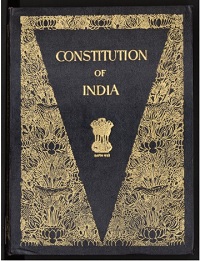Indian Polity and Constitution
Overview:
| Q&A Type: | MCQs (Multiple Choice Questions). |
| Main Topic: | General Knowledge. |
| Sub-topic: | Indian Polity and Constitution. |
| Number of Questions: | 5 MCQs. |
Indian Polity and Constitution MCQs (Multiple Choice Questions) with answers for various state exams and UPSC civil services Exams. Learn and prepare Objective type Questions on Indian Polity and Constitution.
Indian Constitution:

1. With respect to question hour of Parliament, which one can be answered orally?
- Unstarred question.
- Starred question.
- Short notice question.
- Zero hour question.
Answer: (b) Starred question.
Solution: Starred question is distinguished by an asterisk. It requires an oral answer, and hence supplementary questions can follow. The unstarred question requires a written answer, and hence supplementary questions cannot follow.
Solution: Starred question is distinguished by an asterisk. It requires an oral answer, and hence supplementary questions can follow. The unstarred question requires a written answer, and hence supplementary questions cannot follow.
2. When there is a conflict between Directive Principles of State Policies (DPSP) and Fundamental Rights (FR), which one of the following shall prevail?
- Directive principles.
- Supreme Court will decide.
- Fundamental Rights.
- None of the above.
Answer: (d) None of the above.
Solution: If there is a conflict between Fundamental Rights and Directive Principles of State Policies, the order of precedence so far is Fundamental Rights, except 14 and 19, DPSP 39(b) and 39(c).
Solution: If there is a conflict between Fundamental Rights and Directive Principles of State Policies, the order of precedence so far is Fundamental Rights, except 14 and 19, DPSP 39(b) and 39(c).
3. Which article gives the President the pardoning power?
- Article 74.
- Article 72.
- Article 71.
- Article 78.
Answer: (b) Article 72.
Solution: Article 72 of the Constitution provides the president with the right to grant pardons, remit, or commute the sentences of anyone convicted of any crime. The President exercises the power to pardon on the advice of the Council of Ministers.
Solution: Article 72 of the Constitution provides the president with the right to grant pardons, remit, or commute the sentences of anyone convicted of any crime. The President exercises the power to pardon on the advice of the Council of Ministers.
4. Suppose a particular area is brought under the Fifth Schedule of the Constitution of India, which one of the following statements best reflects its consequence?
- This would create a local self-governing body in that area.
- This would convert that area into a Union Territory.
- This would prevent the transfer of land of tribal people to non-tribal people.
- The State having such areas would be declared a Special Category State.
Answer: (c) This would prevent the transfer of land of tribal people to non-tribal people.
Solution: The 5th Schedule mentions the prohibition or restriction of the transfer of land by or among members of the Scheduled Tribes in such areas. It regulates the allotment of land to members of the Scheduled Tribes in such areas. It governs the carrying on of business as a money-lender by persons who lend money to members of the Scheduled Tribes in such areas.
Solution: The 5th Schedule mentions the prohibition or restriction of the transfer of land by or among members of the Scheduled Tribes in such areas. It regulates the allotment of land to members of the Scheduled Tribes in such areas. It governs the carrying on of business as a money-lender by persons who lend money to members of the Scheduled Tribes in such areas.
5. Which one of the following was the exact constitutional status of India on 26th January 1950?
- A Sovereign Secular Democratic Republic.
- A Sovereign Socialist Secular Democratic Republic.
- The Democratic Republic.
- A Sovereign Democratic Republic.
Answer: (d) The Sovereign Democratic Republic.
Solution: The 42nd Constitutional Amendment Act of 1976 was brought to add “Socialist”, “Integrity” and “Secular” to the Preamble. Before this amendment, these words were not in the constitution
Solution: The 42nd Constitutional Amendment Act of 1976 was brought to add “Socialist”, “Integrity” and “Secular” to the Preamble. Before this amendment, these words were not in the constitution
General Knowledge Questions
Indian Polity and Constitution
Indian Polity and Constitution GK MCQs-1
Indian Polity and Constitution GK MCQs-2
Indian Polity and Constitution GK MCQs-3
Indian Polity and Constitution GK MCQs-4
Indian Polity and Constitution GK MCQs-5
Indian Polity and Constitution GK MCQs-6
Indian Polity and Constitution GK MCQs-7
Indian Polity and Constitution GK MCQs-8
Indian Polity and Constitution GK MCQs-9
Indian Polity and Constitution GK MCQs-10
Indian Polity and Constitution GK MCQs-11
Indian Polity and Constitution GK MCQs-12
Indian Polity and Constitution GK MCQs-13
Indian Polity and Constitution GK MCQs-14
Indian Polity and Constitution GK MCQs-15
Indian Polity and Constitution GK MCQs-16
Related Topics
Basic General Knowledge
Biology
Books and Authors
Chemistry
Famous Places
Indian Famous Personalities
Important Dates and Days
Indian Art & Culture
Indian Economy
Indian Environment and Biodiversity
Indian Geography
Indian Ancient History
Indian Medieval History
Indian Modern History
Indian Polity and Constitution
Indian Organizations
International Organizations
Physics
Physical Geography
Sports
World Geography